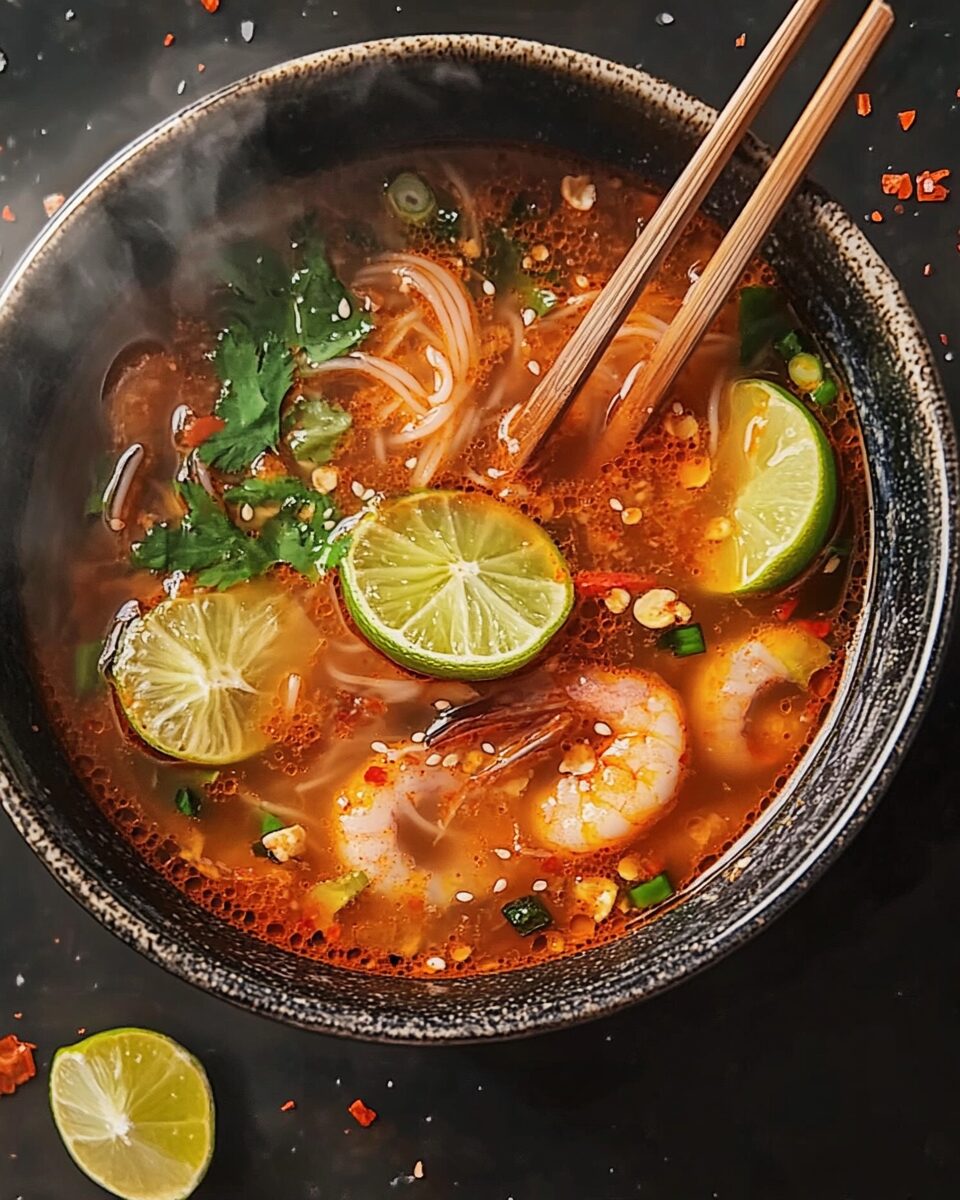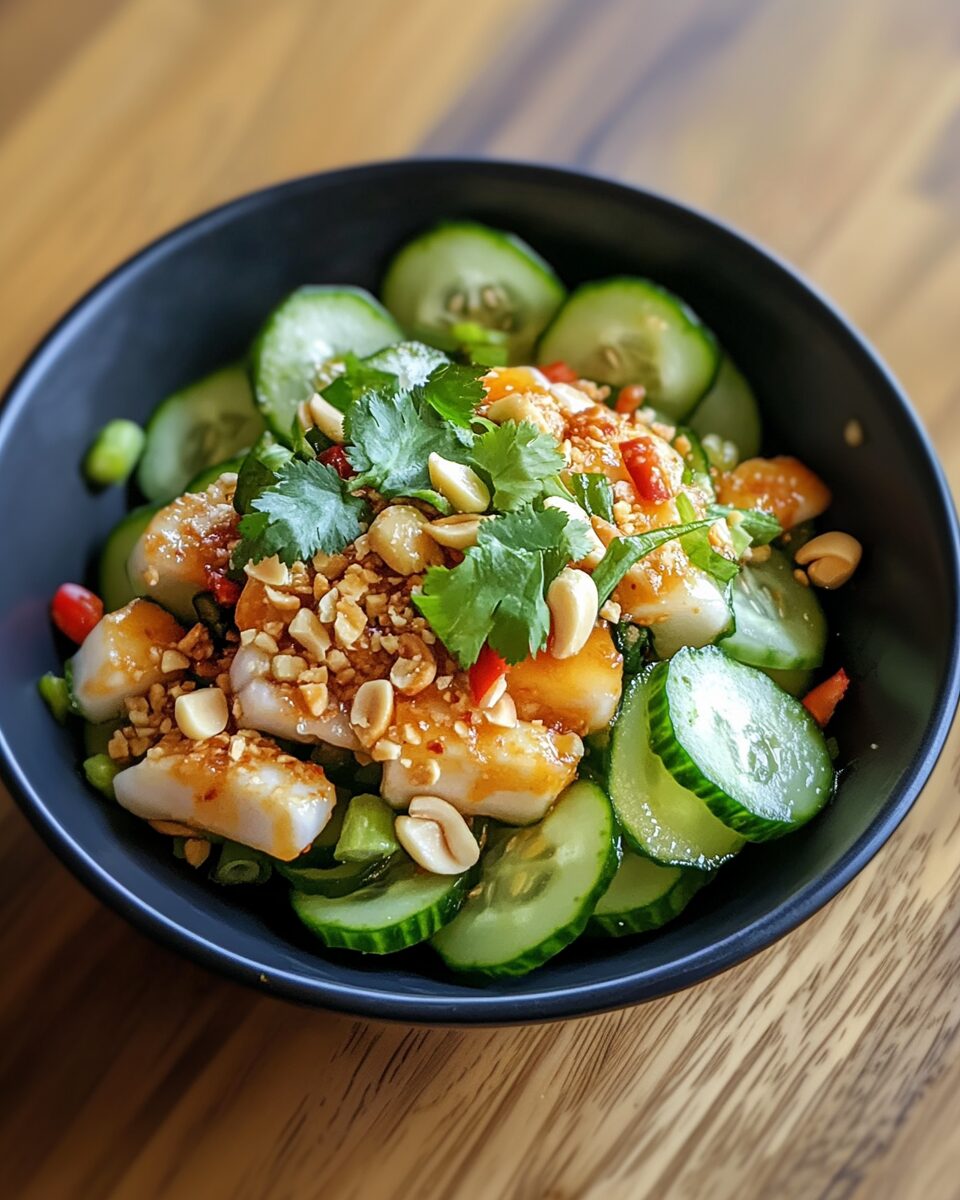Tom Yum Soup is a vibrant and aromatic Thai dish renowned for its harmonious blend of spicy, sour, and savory flavors. Featuring tender shrimp, earthy mushrooms, and a fragrant broth infused with lemongrass, lime, and chili, this soup offers a delightful culinary experience. It’s a perfect choice for those seeking a comforting yet invigorating meal that captures the essence of Thai cuisine.
Full Recipe:
Ingredients
- Shrimp
- Mushrooms
- Tomatoes
- Onions
- Garlic
- Ginger
- Lemongrass
- Lime juice
- Fish sauce
- Brown sugar
- Red chilies
- Chicken stock
- Cilantro
- Vegetable oil
Directions
- Heat vegetable oil in a pot over medium-high heat.
- Add chopped onions and sauté until translucent.
- Stir in minced garlic and ginger; cook until fragrant.
- Add chopped tomatoes and cook until softened.
- Pour in chicken stock and add sliced red chilies; bring to a simmer.
- Add lemongrass and continue to simmer for 15-20 minutes.
- Stir in fish sauce, brown sugar, and lime juice; adjust to taste.
- Add shrimp and mushrooms; cook until shrimp are pink and cooked through.
- Garnish with fresh cilantro before serving.
Nutritional Facts
- Calories: Approximately 250 per serving
- Protein: 20g
- Fat: 10g
- Carbohydrates: 15g
- Fiber: 2g
- Sugar: 5g
- Sodium: 800mg
The Cultural Significance of Tom Yum Soup
Originating in Thailand, Tom Yum Soup is more than just food — it’s a cultural symbol. The dish embodies the principles of Thai cooking, where contrasting flavors and fresh ingredients come together in harmony. Traditionally served as a starter or main course, Tom Yum reflects Thailand’s rich culinary heritage that emphasizes freshness, balance, and a connection to nature.
Tom Yum’s popularity extends beyond Thailand’s borders, now featuring on menus worldwide and embraced by food enthusiasts who seek authentic yet approachable international flavors. Its cultural significance is also tied to its communal nature, often shared among family and friends during meals, highlighting the social aspect of dining in Thai culture.
Flavor Profile and Ingredients Impact
The remarkable taste of Tom Yum Soup arises from its unique combination of key ingredients, each contributing distinct characteristics that elevate the dish. Lemongrass and kaffir lime leaves impart citrusy, fragrant notes, while galangal (a relative of ginger) adds a peppery sharpness. Together, these aromatics create the soup’s signature bright and refreshing base.
The heat comes from fresh or dried Thai chilies, which provide a controlled spicy kick without overpowering the other flavors. Fish sauce delivers a salty umami depth, while lime juice introduces a tangy sourness that brightens the soup.
Shrimp is the classic protein in Tom Yum, offering a tender, sweet contrast to the bold broth. Mushrooms add an earthy texture that complements the other ingredients. Tomatoes contribute a subtle sweetness and a slightly acidic balance, rounding out the complex flavor spectrum.
Health Benefits of Tom Yum Soup
Tom Yum Soup is not only delicious but also packed with nutritional and medicinal benefits. Many of the herbs and spices used have long been revered for their health-promoting properties.
-
Lemongrass is known for its antioxidant and anti-inflammatory effects and may aid digestion.
-
Galangal has antimicrobial properties and is often used in traditional medicine to treat respiratory issues.
-
Chilies boost metabolism and can help improve circulation.
-
Garlic and onions add immune-supporting compounds and antibacterial effects.
-
Lime juice is rich in vitamin C, promoting skin health and immune function.
Combined, these ingredients make Tom Yum Soup a nutritious option, often consumed to help alleviate cold symptoms or simply to enjoy a flavorful, low-calorie meal packed with vitamins and minerals.
Tom Yum Soup as a Comfort Food
In many Thai households, Tom Yum Soup is considered comfort food. The spicy heat warms the body, the sour notes refresh the palate, and the broth soothes the soul. For those unaccustomed to spicy cuisine, Tom Yum can be adjusted to milder levels, making it accessible and enjoyable for a wider audience.
The warmth and complexity of Tom Yum also make it a popular choice during cooler months or when someone is feeling under the weather. Its ability to stimulate appetite and clear nasal passages makes it a favored remedy in Thai culture.
Tom Yum Variations
While shrimp is the traditional protein, Tom Yum Soup has many variations that cater to different tastes and dietary needs. Some popular alternatives include:
-
Tom Yum Gai: Chicken is used instead of shrimp, offering a milder, equally flavorful option.
-
Tom Yum Talay: A seafood version that includes a mix of shrimp, squid, fish, and mussels for a richer seafood experience.
-
Vegetarian Tom Yum: Made with tofu and vegetable broth, this variation caters to vegetarians and vegans while maintaining the characteristic flavors.
-
Tom Yum Noodle Soup: Combining noodles with Tom Yum broth creates a hearty meal, perfect for lunch or dinner.
These adaptations showcase the versatility of Tom Yum, allowing it to fit various dietary preferences without losing its essence.
Tom Yum Soup in Modern Cuisine
Tom Yum Soup has transcended traditional dining and is now embraced in fusion and modern cuisine. Chefs worldwide experiment with its flavors in different formats—Tom Yum risotto, Tom Yum-inspired cocktails, or even Tom Yum-flavored snacks.
The soup’s bold flavor profile makes it a perfect candidate for innovative culinary techniques, where traditional Thai ingredients blend with international styles to create new experiences. Despite these modern twists, the authentic Tom Yum Soup remains a beloved classic, preserving the heart of Thai culinary tradition.
Pairing Tom Yum Soup with Other Dishes
Tom Yum Soup’s intense and vibrant flavors make it a fantastic pairing partner for various dishes. It complements milder flavors well and can be part of a balanced Thai meal.
-
Rice dishes: Plain jasmine rice or sticky rice helps mellow the strong flavors.
-
Thai salads: Fresh and crunchy salads like Som Tum (green papaya salad) add texture and freshness.
-
Grilled meats: The acidity and heat of Tom Yum cut through the richness of grilled pork or chicken.
-
Desserts: Light, coconut-based sweets such as mango sticky rice provide a cooling contrast after the spicy soup.
By pairing Tom Yum with other complementary dishes, you can create a well-rounded meal that highlights the depth of Thai cuisine.
Serving and Presentation Tips
Presentation plays a vital role in the enjoyment of Tom Yum Soup. Traditionally served in a bowl garnished with fresh cilantro and sliced chilies, it looks as vibrant as it tastes.
Serving the soup in a clear bowl showcases the colorful ingredients—red chilies, green herbs, and white shrimp against the bright orange broth—enhancing the visual appeal. Using fresh garnishes like kaffir lime leaves or a wedge of lime adds to the aroma and flavor experience.
For home cooks, investing in quality fresh herbs and aromatics makes a noticeable difference in the final dish. Serving Tom Yum with a side of steamed rice helps balance the bold flavors and makes the meal more filling.
Tom Yum Soup’s Place in a Healthy Diet
Tom Yum Soup fits perfectly into a healthy and balanced diet. It’s naturally low in calories and fat, making it suitable for weight management. The soup is also rich in protein and packed with vegetables and herbs, providing essential nutrients.
Avoiding heavy cream or coconut milk versions keeps the soup light. Additionally, the use of fresh herbs and spices supports digestion and boosts immunity, making Tom Yum a nutritious choice for everyday meals.
Conclusion
Tom Yum Soup is much more than a traditional Thai dish; it’s a celebration of flavors, culture, and health. Its bold combination of spicy, sour, salty, and sweet elements creates a complex yet balanced taste that delights the senses. From its cultural roots to its modern variations, Tom Yum continues to captivate food lovers around the globe.








